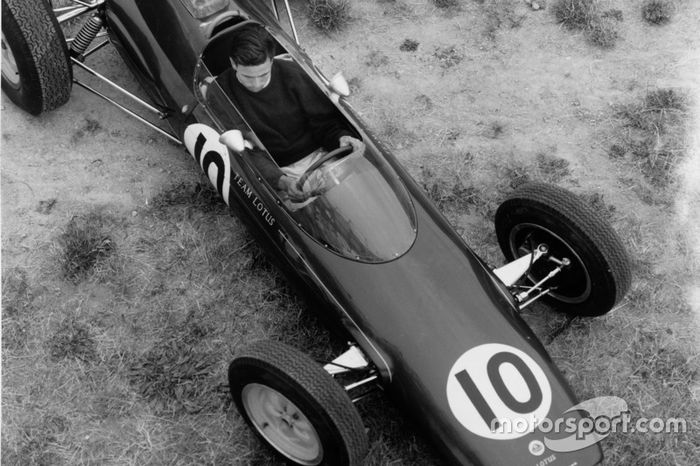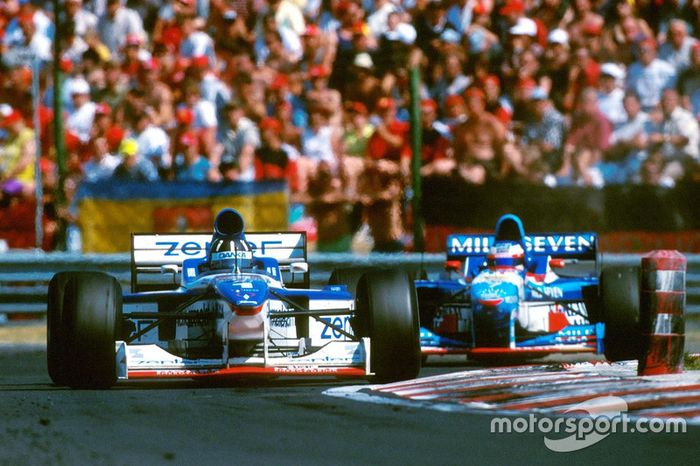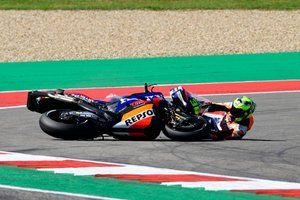The front-engined Alfa Romeo 158 produced around 400 bhp and dominated the first two F1 championships in 1950 and '51.
After Alfa Romeo withdrew from the sport, very few teams had cars that conformed to the F1 regs. This lea to the championship running F2-spec cars for two years.
The championship returned to F1-spec machinery in 1954 as part of new regulations that stipulated 2.5-litre non-turbocharged engines. Mercedes came out with the legendary W196 with closed-wheels.
Stirling Moss driving the rear-engined Cooper T43
Lotus 25 was the first car with a monocoque chassis
In 1960s F1 cars started resembling capsules - long and tightly packed.
Lotus 49B popularised the now-ubiquitous front and rear wing
At a time when there were no computer systems, designers tested various devices to increase downforce. Here's Graham Hill driving a car with additional high wings which were affixed to front and rear suspensions.
Regulations regarding front and rear wings were tightened following several accidents.
The Lotus 72 was the first car to install cooling system on the sides of the car, leading to the origin of sidepods.
Slick tyres being used for the first time
In addition to sidepods and wings, F1 cars now featured engine cover and airbox.
The six-wheeled Tyrrell P36 won the Swedish GP in 1976.
James Hunt's McLaren M23 with a double airbox design.
Renault introduced turbo engines into F1, but their initial years were marred by technical gremlins.
Lotus is known to pioneer 'ground effects'. By turning the car effectively into an inverted airplane wing, Lotus was able to produce significantly more downforce than its rivals.
McLaren became the first team to use a carbon fibre monocoque, which has since been adopted by the entire grid.
Brabham under Bernie Ecclestone's leadership started with the practice of mid-race refuelling, allowing it to run a lighter car throughout the race.
Because of the amount of downforce generated by the underbody, front wings were no longer needed at certain tracks.
Turbo engines started crossing the 1000 bhp mark, giving them an edge over naturally-aspirated counterparts. During this time, cars often ran out of fuel before the end of the race,
1988 was the last year turbo engines were allowed in F1 before being reintroduced in 2014. Seen in the photo is the McLaren MP4-4, which romped to 15 victories in 1988 - missing out on just one win at Monza.
The shape of the cars became more sleep and aerodynamic.
Tyrrell 019 marked an evolution by bringing an elevated nose.
An early form of bargeboard, seen on the McLaren MP4-8 driven by Michael Andretti.
Electronic devices like traction control, launch control and active suspension became prominent. Williams driver Alain Prost dominated the season to win his fourth title, while McLaren's Ayrton Senna claimed five wins, including a memorable one at Donington Park.
Most of the driving and electronic aids were banned ahead of start of the 1994 season. Ayrton Senna and Roland Ratzenberger died during a tragic weekend at Imola.
Safety became a priority in the aftermath of Imola 1994. The cockpit's opening was made larger and the sides raised to provide better head protection.
High noses became common. 1997 was the last year of slick tyres until they were reintroduced in 2009.
For 1998, the car's track was reduced from 2m to 1.8m. The front tyres had three grooves, while rear had four after the ban on slick tyres. All these changes were made to reduce cornering speed and increase overtaking.
Front tyres now had four grooves.
The year in which majority of lap records were broken.
F1 switched to 2.4-litre V8 engines
2008 cars used several aerodynamic wings and winglets.
New era, new looks. Slick tyres were reintroduced, while KERS was a new addition to the series. Changes were also made to the wings.
As part of a safety measure, FIA made changes to the nose cone, leading to the much-hated stepped noses. An year earlier, FIA introduced DRS to aid overtaking.
New 1.6-litre hybrid engines introduced that significantly changed the pecking order. Nose cones continued to look ugly, with the Caterham CT05 (pictured) making the worst-looking interpretation of the new rules.
Teams came up with different nose designs, with the 'finger'-shaped nose being the most popular. However, Lotus came up with something extremely different.
Some teams continued to use finger noses, although they were much shorter and far more visually appealing.
2017 revamp focused on making cars faster and harder to drive.



















































Top Comments